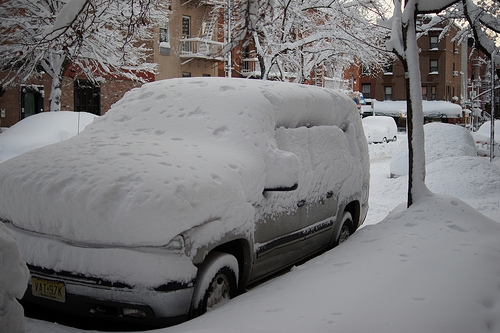Driving in the wintertime is always a gamble if you live in an area with a snowy climate. But even when you plan ahead and try to stay off the roads during storms, it’s always a possibility that a blizzard could hit without much warning. Prepare now for how you’ll react if this happens to you.

Slow Down
It’s the simplest tip for driving in snow, but it’s also the most effective. Driving too fast on snow-packed and ice-covered roads is the worst thing you can do. Higher speeds make it more difficult to ease to a stop, and hitting the brakes during a blizzard could cause your car to slide into another vehicle or a snow bank.
No matter what type of car you drive, whether it’s a massive truck with all-wheel drive or a sports car with rear-wheel drive, braking is an equalizer in the snow. There are no features that will prevent sliding when the roads are icy, so take it slow and steady.
Find a Safe Place to Pull Over
Pulling over into a big pile of snow is definitely not the right thing to do on the road. Your tires could get stuck, leaving you stranded in a dangerous situation. But if you can find a parking lot or other safe place to pull over and park, do it. When the snow is coming down and the wind is blowing, it’s very difficult to see the road and stay within the lane lines, putting you and other drivers at risk. If you can park for a little while and wait it out, you could avoid a potentially fatal accident.
Keep an Emergency Kit in the Car
No one wants to think about the worst possible scenario, but it’s always better to prepare now. Before you head out on the roads during the winter months, pack an emergency kit and keep it in the trunk. It should include a small shovel, an ice scraper, some nonperishable food items, water bottles, a flashlight, a blanket, and some warm clothes. If the worst does happen and you end up stranded somewhere, you’ll be glad to have a few essentials that could keep you alive until the storm passes.
Follow in Other Tire Tracks
It’s unlikely that you’ll be the only car on the road, even in a blizzard. It’s always smart to follow in another car’s tire tracks on the road instead of blazing a trail yourself. Packed snow often hides ice, and both of these conditions make driving treacherous and dangerous. Don’t follow too closely, but take advantage of the tracks that will get your tires closer to the road, improving the traction.
Keep Lights On
Blizzards make it hard to see other cars, so keep your lights on even during the daytime to improve visibility. When the snow falls, make sure to turn on your windshield wipers on to keep the glass clear.
It’s always safer to stay off the roads when the conditions are poor, if at all possible. But if you get stuck in a blizzard, drive slowly and use extreme caution to protect yourself and others.